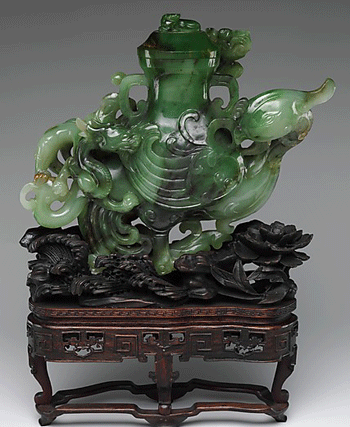Stone carving is one of the oldest arts in China, its beginnings dating back to remote antiquity. Although jade, the mineral nephrite, was held in the highest esteem, all stones that could achieve a luster after polishing, be it agate, turquoise, malachite, chalcedony, quartz, jasper, or lapis lazuli, were also appreciated. Stone carving experienced an efflorescence during the Qing dynasty (1644–1911), when an abundant supply of raw materials, exceptionally accomplished craftsmen, and, in particular, keen imperial patronage contributed to the creation of numerous superb works.
The stone carvings of the Qing period can be grouped in three categories: personal adornments such as rings, bracelets, and pendants; articles for daily use (mainly in the scholar's studio) such as brush holders, water pots, and seals; and display pieces such as copies of antiques, miniature mountains, and animal and human figures, the latter being the largest of the group. The carvings can also be classified by their decorative style: archaic or classical, meaning their shapes were derived from ancient ritual vessels; "Western," which bore the influence of contemporary Mughal art from northern India; and new or modern, meaning novel shapes and designs created during the Qing dynasty.
A common decorative theme, especially among works of the new style, was the use of rebuses, which are symbols associated with auspicious meanings, to convey wishes for prosperity, longevity, good fortune, perpetuation of a family line, or academic success. The tradition began early but remained largely in the popular culture until the sixteenth and seventeenth centuries, when significant social changes and increased imperial patronage helped elevate the rebus to the high art of the court.

